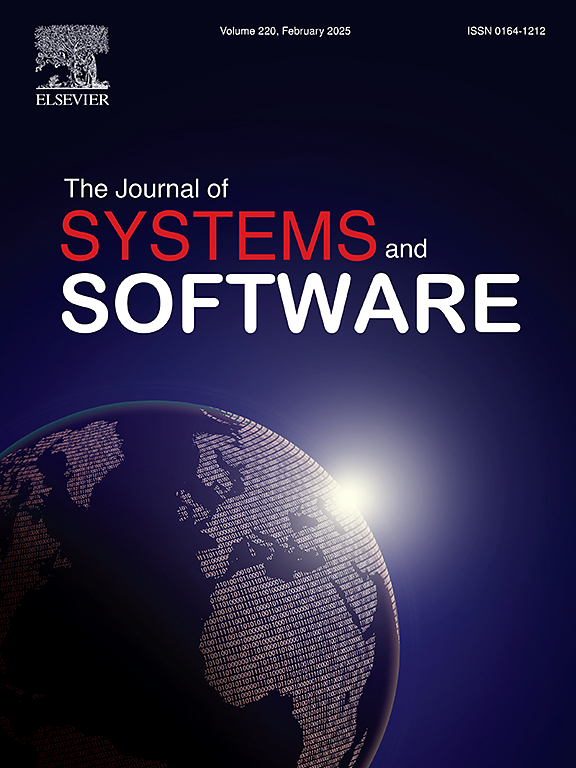Hierarchical tree-based algorithms for efficient expression parsing and test sequence generation in software models
IF 3.7
2区 计算机科学
Q1 COMPUTER SCIENCE, SOFTWARE ENGINEERING
引用次数: 0
Abstract
The software expression model serves as a formalized specification, accurately depicting software behavior and generating test sequences through algebraic operations derived from the model. Typically, automated algebraic manipulation involves constructing an abstract syntax tree (AST) for the expression, followed by traversing it to identify subexpressions. However, this approach introduces a significant amount of redundant algebraic operations, diminishing the efficiency of expression parsing. To address this challenge, this paper introduces HT-EP, an innovative hierarchical tree-based expression parsing algorithm. HT-EP transforms expressions into hierarchical trees, utilizing algebraic operations to process nodes efficiently and generate streamlined test sequences. Compared to ASTs, hierarchical trees exhibit a simplified structure with fewer nodes, enabling faster traversal. Our experiment involved 124 expressions from scholarly papers over the past six decades and core functional expressions from 15 open-source software projects. The goal was to assess the parsing and fault detection capabilities of HT-EP against four other expression parsing algorithms. Additionally, we compared the complexities of hierarchical trees and ASTs, exploring factors influencing hierarchical tree complexity. Experimental results reveal that the HT-EP algorithm excels in parsing and software fault detection capabilities compared to the other four algorithms. Furthermore, for expressions derived from real-world cases, HT-EP achieves an approximate 40% reduction in redundant algebraic operation steps and an average 63% reduction in runtime compared to AST-EP.
软件模型中高效表达式解析和测试序列生成的分层树算法
软件表达式模型是一种形式化的规范,可准确描述软件行为,并通过从模型衍生出的代数运算生成测试序列。通常,自动代数操作包括为表达式构建抽象语法树(AST),然后遍历该语法树以识别子表达式。然而,这种方法引入了大量冗余代数操作,降低了表达式解析的效率。为了应对这一挑战,本文介绍了 HT-EP,一种创新的基于层次树的表达式解析算法。HT-EP 将表达式转化为分层树,利用代数运算高效处理节点并生成精简的测试序列。与 AST 相比,层次树结构简化,节点数量更少,因此遍历速度更快。我们的实验涉及过去六十年学术论文中的 124 个表达式和 15 个开源软件项目中的核心功能表达式。目的是评估 HT-EP 与其他四种表达式解析算法的解析和故障检测能力。此外,我们还比较了层次树和 AST 的复杂性,探索了影响层次树复杂性的因素。实验结果表明,与其他四种算法相比,HT-EP 算法在解析和软件故障检测能力方面更胜一筹。此外,对于源自真实世界案例的表达式,与 AST-EP 相比,HT-EP 减少了约 40% 的冗余代数运算步骤,平均缩短了 63% 的运行时间。
本文章由计算机程序翻译,如有差异,请以英文原文为准。
求助全文
约1分钟内获得全文
求助全文
来源期刊

Journal of Systems and Software
工程技术-计算机:理论方法
CiteScore
8.60
自引率
5.70%
发文量
193
审稿时长
16 weeks
期刊介绍:
The Journal of Systems and Software publishes papers covering all aspects of software engineering and related hardware-software-systems issues. All articles should include a validation of the idea presented, e.g. through case studies, experiments, or systematic comparisons with other approaches already in practice. Topics of interest include, but are not limited to:
•Methods and tools for, and empirical studies on, software requirements, design, architecture, verification and validation, maintenance and evolution
•Agile, model-driven, service-oriented, open source and global software development
•Approaches for mobile, multiprocessing, real-time, distributed, cloud-based, dependable and virtualized systems
•Human factors and management concerns of software development
•Data management and big data issues of software systems
•Metrics and evaluation, data mining of software development resources
•Business and economic aspects of software development processes
The journal welcomes state-of-the-art surveys and reports of practical experience for all of these topics.
 求助内容:
求助内容: 应助结果提醒方式:
应助结果提醒方式:


